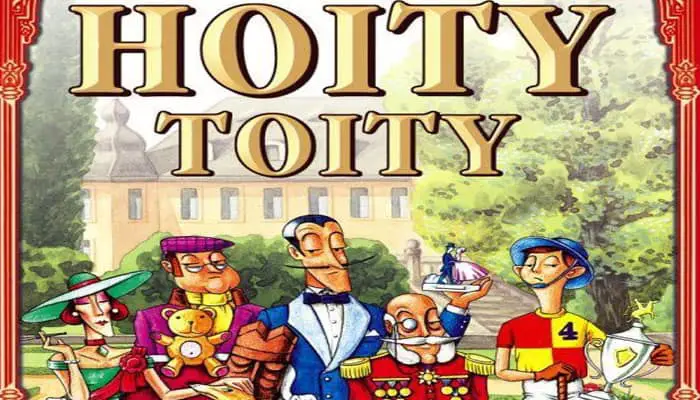
Components

- 1 gameboard
- 6 Figures
- 48 action cards
- 51 collection cards
- 1 rulebook
The Game Board
The game board shows the interior of the 'Antique Club'. Players start with their figures in the Club Room and head towards the prestigious Dinner Banquet On your way to the Dinner Banquet, you will pass Castles where the exhibitions take place. In between the individual spaces are octagonal areas that contain 2 numbers.
The numbers indicate how far players may advance their figures. Now look at the center of the game board. There you see an Auction Hall with two display windows and a cash register Further up the board lies the prison with six prison cells which detain arrested thieves.

Cards
Action cards indicate which actions are possible at what places. The backs of the Action cards display the number 2.

Collectibles cards show the objects of everyone's desire. These cards show all the different collectible items in six different categories (A-F). The ages of the objects are indicated on the top of the Collectibles cards the older an object, the more valuable it is. Players use these cards to put together an exhibit.
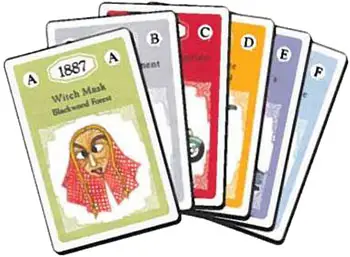
Setup
Pick a color
In order to determine a player's color, one player takes a Castle card of each color (total of six) and shuffles them. Place the cards face down on the table and have each player pick a card.
Take place cards and action cards
Each player now receives the rest of the cards in his color, i.e the Auction Hall card and the 8 Action cards. If there are less then six players, the leftover cards are removed from the game.
Take your play figure
Each player takes the triangular play figure of his color and places it in the Club Room on the game board.

Hand out Collectibles cards
Shuffle the 51 Collectibles cards thoroughly and give each player four face down cards. Players may look at their cards. They then place the cards face down in front of them.
The remaining Collectibles cards are divided into two roughly equal sized stacks and placed face up in the two windows of the Auction Hall. This ensures that there are always two stacks of Collectibles cards to choose from.
Note: It is not permitted to look at the cards underneath the cards on top of the two card stacks.

Game Play
The game is played in several rounds. Each round consists of four phases that are repeated in each subsequent round:
Phase I (Where?): All players designate a place of their choice, either a Castle or an Auction House. They play a Place card (a card with #1 on the back) simultaneously to designate where they want to go
Phase II (What?): All players simultaneously designate with the Action cards (with #2s on the back) what action they want to perform at their chosen place.
Phase III (Auction Hall): Players who decided to go to the Auction Hall play their action cards.
Phase IV (Castle): Players who decided to go to the Castle play their action cards.
Phase I: "Where"

In this phase, all players decide where they want to go - either to the Auction Hall or the Castle.
Once a player has decided on which place to go. he places one of his place cards (with a 1 on the card back) face down in front of him. After all players have chosen their place cards, they flip them face up simultaneously.
Now each player is aware of the place that the other players have chosen to visit. However, nobody knows what actions the other player will choose at those locations This is revealed in the following phase.
Phase II: "What"

After having selected where to visit, (Place cards remain face up in front of the players), everybody chooses what action to perform at die chosen place. At this point, you can start to guess the intentions of the other players.
Here are the options:

Auction Hall
Players in the Auction Hall can either:
acquire one of the two top Collectibles cards on top of the two stacks in the Auction Hall by paying for them with a Cash card.
steal cash from the cash register that the other players played on the same turn.
Note: The Detective may not be used in the Auction Hall.
Castle

Players in the Castle can either:
play an Exhibit card, granted that a player owns enough Collectibles cards to put on an exhibit.
steal Collectibles cards from other players exhibits with a Thief.
arrest and jail other players Thieves with your Detective.
How do you put on an exhibit?
You can put on an exhibit when you have a minimum of three Collectibles cards (no limit upwards) linked together in alphabetical order.

Example: The following Collectibles card orders are legitimate exhibits AAA, AABBC, CDEE. However, these card orders cannot be counted as exhibits AB (too short). BCE (interruptions in alphabetical order).
Note: If you do not have 3 or more cards in a legitimate order, you may not play the Exhibit card.
Phase III: Play actions in the Auction Hall
Players who played the Castle card in phase 1 do not perform any actions during this phase and must wait until phase IV!
All other players now pick what Action card to play They then lay their card face down next to their face up Place card Once all players are ready, each person flips over their Action cards simultaneously.
Players who played a Cash card go first, followed by the player(s) who played a Thief.
-
Cash Cards

The player who played the largest amount of cash, takes one Collectibles card from either one of the Auction Hall window's The acquired Collectibles card is placed with the player s other Collectibles cards. The player then places the Cash card face up on the cash register field.
All other players with a smaller amount shown on their cash card may not take a Collectibles card. However, they may take the Cash card back into their hand for future use in die game.
-
Thieves
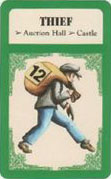
If you played a Thief, you may steal the newly played Cash card from the cash register. The stolen cash may be used in any one of your future rounds of the game if nobody paid any cash that round the Thief leaves empty handed. Thieves may not steal cards that were placed on the cash register field in previous rounds.
Note: If more than one player played a Thief card nobody receives cash!
Players take all Thieves played in the Auction Hall back into their hands, regardless of whether they were successful or not with their heist.
Finally, players conclude the third phase by picking up their Auction Hall place card and putting it back into their hand of cards.
Note: Should there be no Collectibles cards left for purchase after several rounds of the game, the game play occurs only in the Castle (described in the following section).
Phase IV: Play actions in the Castle
All players who played the Castle card in phase 1, now choose their action card. All players flip their Action cards to a face-up position simultaneously. Now, perform the three possible actions in the following order:
1. Exhibits
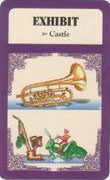
All players who played the Exhibit card must now display al least three Collectibles cards (in uninterrupted alphabetical order) that make up their exhibit If a player can display more than one exhibit, chose only one to display.
If two or more players decided to put up an exhibition, they secretly combine the required cards and then all players reveal their exhibits at the same lime. Be careful that nobody sees how many cards you will display for your exhibit before simultaneously revealing your collection to the other players.
Whoever has the most cards in her collection, automatically has created the most valuable exhibit. In the case of a tie, the player with the oldest object in her exhibit has the most valuable exhibit.
After having determined die most valuable exhibit, identify the player with the second most valuable exhibit If only one player show's an exhibit she automatically has die most valuable exhibit

All exhibits, regardless of their value, remain openly displayed in front of the players until the end of phase IV!
The two players with the most valuable and second-most valuable exhibit may now move their triangular game figures forward along the Castles of the score track.
Important: The number of spaces that a player may advance on the score track depends on the position of the leading player on the score track. The field on which the leading player is positioned, houses a smaller octagonal space with two numbers in it.
The higher number indicates how far the player with the most valuable exhibit may advance. The lower number shows how far the player with the second-most valuable exhibit may advance.
Only the two players with the most valuable exhibits score points, the other players leave empty-handed.

Note: At the beginning, when all wooden playing figures are on the starting field of the Club Room, the two numbers in the octagonal space in the Club show how far the players with the most valuable exhibits may advance.

Example: The player with the blue playing figure has the most valuable exhibit. The two figures in the lead on the score track, beige and purple are positioned next to the octagonal space with the numbers 3/2. Therefore, the blue figure advances 3 spaces. Player green, with the second most valuable exhibit, moves ahead 2 spaces.
2. Thieves
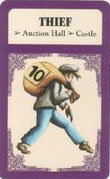
The action of the Thieves are resolved once the players have received their scores for their exhibits.
Each player who played a Thief card in the Castle may take one Collectibles card of their choice from the exhibit of each player. This is a tricky way to build your collection, in addition to acquiring Collectibles cards from the Auction Hall!
If more than one player played a Thief, the Thief with die highest number, indicating years of experience, steals first followed by the Thief with the next lower number and so on.
If no player put on an exhibition that round, the Thieves leave the Castle empty handed.
3. Detective

After all the Thieves have taken their bounty, Detectives come into play If at least one Detective has been played, all Thieves automatically go to jail - regardless of whether they have stolen something or not.
Even though the Thieves are jailed, players who played Thief cards still retain the stolen Collectibles, so their bounty remains safe.
If at least one Thief was played, players who played Detectives look where their playing figures stand on the score track. The player who is most ahead on the score track may advance by one field. The player in second position may advance 2 fields, the player in third position may advance 3 fields and so on.
To sum up, every player who played a Detective, and if at least one Thief was played, moves ahead the number of fields that corresponds to his position relative to others on the score track.

Example: A Thief was caught and arrested Players red green and purple played their Detectives. Red may advance one field, Green 3 fields and purple 4 fields.
Of course, if no player played a Thief in the Castle, players who played Detectives are not rewarded.
The Prison

All arrested Thieves end up in jail at the center of the game board. The Thief who was caught first, enters cell number 1. Whenever a new Thief enters the jail, all Thieves already in jail, rotate up to the next cell number.
If two or more Thieves are caught in a game round, they' all go to jail - Thieves with the lowest numbers enter first and then Thieves with the highest numbers last.
The number of prison cells corresponds to the number of players in a game In a six player game all prison cells 1 through 6 are used in the game In a five-player game, only cells 1-5 are used, and so on
Once a Thief moves out of the last prison cell, because of new Thieves entering the prison, the player who owns that Thief takes the card back into his hand. The player who regained his Thief may now use him again in future rounds.

Example: In a four player game, a new Thief is caught and enters prison cell 1. All other previously Jailed inmates move on to the next prison cells. The illustration shows how the Thief with the number 9 leaves the prison as the Thief with number 11 enters the first prison cell.
Note: Thieves that are played in the Castle apply only in the Castle. If they are not caught by a Detective, players take them back to their hands at the end of the phase.
Thieves that are played in the Auction Hall (in game phase III) count only there, and players take them back into their hand of cards at the end of phase III. In other words, a Detective played in phase IV cannot arrest Thieves played in phase III.
Players finish phase IV by taking their Place and Action cards back into their hand of cards Players who displayed an exhibit, places the Collectibles cards back in front of them (face down).
End of the Game
Game play continues until one player has reached any field on the big Dinner Banquet.

Then, players receive one last chance to score their exhibits. Each player puts on the best exhibit that he can produce. The player with the most valuable collection receives 8 points on the score track and the player with the second most valuable exhibit scores 4 points.
After this final exhibit, the player who is the farthest ahead on the score track wins the game.
If two or more players are tied (i.e. on the same scoring field), the player with the most valuable exhibit wins the game.
Note: The game is most fun, when you play with 3-6 players. However, an optional 2-player game has its own tactical appeal.
Rules for two-player games
1. The Surprise Variant
Both players decide to play a Place and Action card at the same time (phase 1 and 11 together). They choose the cards, put them face down in front of them and reveal them simultaneously.
2. The Confrontation Variant
Place cards (phase 1) are omitted. Both players are always at the same place, whereas the place changes from round to round In the first round, both players are in the Auction Hall.
In the second round both players are in the Castle and in the third round, they meet in the Auction Hall again and so on.
As a reminder to both players, the place is announced before both players play their Action cards.
Continue Reading
